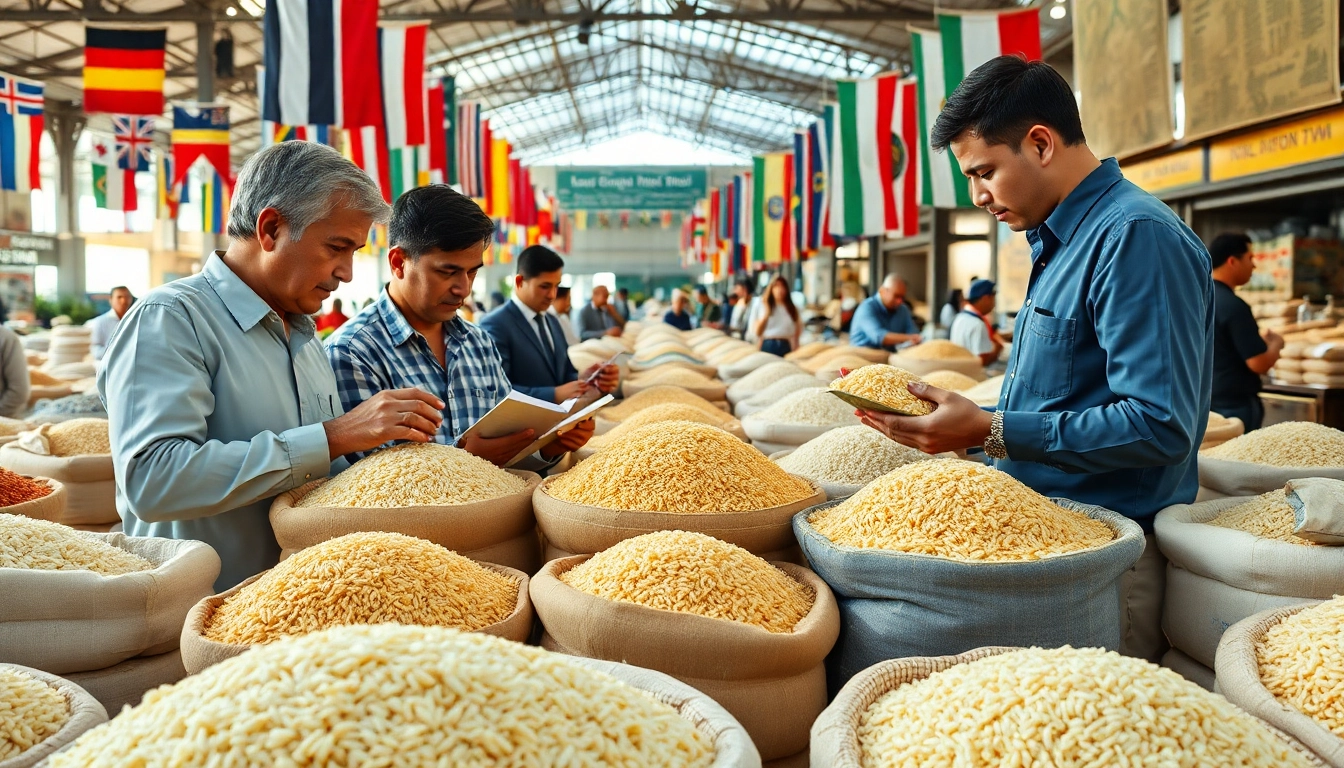
Understanding the Role of Rice Importers in Global Trade
Rice is a staple food that sustains billions of people around the world. As global demand continues to rise, the role of rice importers has become increasingly critical in ensuring that this essential grain reaches those who need it. In this article, we delve into the complexities of the rice supply chains, the importance of reliable importers, emerging market trends, and the challenges faced by rice importers in navigating a globalized food system.
Overview of Rice Supply Chains
The rice supply chain is a multifaceted network involving various stakeholders—from farmers and millers to wholesalers and retailers. Rice is produced in numerous countries worldwide, with notable production hubs in Asia, the Americas, and Africa. After harvesting, the grain undergoes processing, which includes cleaning, milling, and packaging before it reaches importers.
Importers play a crucial role in this chain. They connect rice-producing regions with markets across the globe, facilitating the transfer of goods that meet the preferences and dietary needs of diverse populations. Key factors influencing these supply chains include production levels influenced by climate, agricultural practices, trade policies, and global economic conditions.
The Importance of Reliable Importers
Reliable importers are essential for maintaining the flow of rice into markets where it is not produced in sufficient quantities. They help cushion the impact of localized agricultural failures by sourcing rice from various regions, thereby ensuring food security. Importers must understand the variations in rice types—such as long-grain, medium-grain, and aromatic varieties—while also being aware of market demand trends.
Furthermore, establishing good relationships with suppliers allows importers to negotiate better terms, ensuring a stable price environment and reducing the risk of supply disruptions. Importers also often provide valuable market insights back to producers, contributing to a more efficient and effective supply chain.
Market Trends Affecting Rice Importing
The rice import market is influenced by several evolving trends, including dietary shifts, economic changes, and climatic events. Increasing consumer preference for specialty rice varieties, such as basmati and jasmine, signifies a notable market shift. Additionally, trade agreements and tariffs can reshape the landscape of rice imports by affecting which countries can competitively supply rice.
Technological advancements, such as improved logistics and supply chain management software, also play a vital role in enhancing the efficiency of rice importers. These innovations can ease the processing of shipments and improve tracking, ensuring a more reliable supply of rice to markets.
Key Players in the Rice Importing Sector
Top Rice Importers in the USA
The U.S. rice import industry is dominated by several key players. Companies like Archer Daniels Midland Company, Cargill Inc., and Ricetec Inc. are among the largest rice importers in the country. These companies leverage their extensive supply chains and market knowledge to cater to a diverse customer base, including food manufacturers, retailers, and food service providers.
Archer Daniels Midland Company stands out for its integrated supply chain that spans global operations, allowing it to efficiently source rice from numerous countries and maintain product quality. Similarly, Cargill offers a robust inventory management system that aids importers in optimizing stock levels based on market demand.
Notable International Rice Importers
Globally, several countries are significant rice importers, including China, India, and the Philippines. The Philippines has emerged as the largest rice importer in the world, reflecting its reliance on imports to meet domestic consumption needs. Importers in these regions not only facilitate supply but also influence local pricing and availability.
Other notable countries such as Indonesia and Saudi Arabia also feature prominently in rice importing, albeit for different reasons. For instance, Indonesia imports large quantities of rice to stabilize prices and ensure food security amid fluctuating production levels.
Industry Influencers and Trade Associations
Trade associations such as the USA Rice Federation and the International Rice Research Institute serve as significant influential bodies within the industry. They advocate for policies beneficial to the rice trade while providing resources, market data, and networking opportunities to rice importers worldwide.
These organizations also contribute to research initiatives aimed at improving rice production techniques and market strategies, making it easier for importers to make informed decisions. Following their insights can help importers gain a competitive edge in an ever-evolving market landscape.
Challenges Faced by Rice Importers
Regulatory Hurdles and Compliance
Rice importers face a plethora of regulatory hurdles, including import tariffs, sanitary and phytosanitary regulations, and compliance with international trade laws. Different countries have varying standards, making it imperative for importers to stay abreast of compliance requirements to avoid costly penalties and shipment delays.
As stricter food safety regulations are implemented globally, importers must invest considerable time and resources in ensuring that their sourcing practices align with these regulations. Establishing communication with customs authorities and staying updated on changes in trade policies can help mitigate these challenges.
Pricing Volatility and Supply Issues
The rice market is subject to significant pricing volatility due to fluctuating supply levels impacted by climate change, cultivation practices, and geopolitical tensions. Importers must navigate these challenges while keeping their costs manageable for consumers. Effective inventory management and forecasting can aid rice importers in smoothing out the impacts of price fluctuations.
One strategy that can be employed is diversifying sourcing regions. By establishing relationships with multiple suppliers across different geographies, importers can mitigate the risk of supply disruptions caused by localized issues such as natural disasters or political instability.
Logistics and Transportation Challenges
Efficient logistics and transportation are critical aspects of rice importing. Importers face various logistical challenges, including managing shipping schedules, dealing with port congestion, and ensuring the timely delivery of goods. The recent global disruptions to shipping and transportation due to the pandemic have further highlighted vulnerabilities in this area.
To counteract these challenges, importing companies should consider investing in robust supply chain management systems that incorporate real-time tracking and predictive analytics to improve decision-making. Establishing relationships with reliable logistics partners can also enhance operational efficiency.
Best Practices for Successful Rice Importing
Establishing Strong Supplier Relationships
Building and maintaining strong relationships with suppliers is one of the cornerstones of successful rice importing. Importers should invest time in understanding their suppliers’ operations, quality standards, and business goals. Regular communication and feedback can facilitate better collaboration and ultimately lead to improved product quality and service.
Long-term partnerships can often result in more favorable pricing arrangements and priority access to sought-after rice varieties, enabling importers to respond swiftly to market demand.
Leveraging Technology for Efficiency
In today’s data-driven environment, leveraging technology is crucial for maximizing operational efficiency. Importers can utilize various tools, including supply chain management software, e-commerce platforms, and customer relationship management (CRM) systems to enhance their operational capabilities.
Automation in logistics management, inventory tracking, and order processing can lead to significant reductions in overhead costs while improving response times and customer satisfaction. British rice importer Hampson’s is an excellent example, utilizing advanced technology to streamline operations from sourcing through to distribution.
Adapting to Market Changes
Market dynamics in the rice import sector can change rapidly. Adapting to these changes through continuous market research, competitor analysis, and consumer trend monitoring can equip importers to make informed decisions. It is essential for importers to be flexible in their strategic planning, ready to pivot in response to emerging trends or challenges, whether they pertain to changing consumer preferences or economic shifts.
Utilizing insights gleaned from trade associations and market reports can provide valuable information, guiding importers in adjusting their sourcing strategies and marketing approaches.
Future Outlook for Rice Importers
Market Projections and Growth Opportunities
The future of rice importing looks promising, particularly as global demand is expected to grow steadily in the coming years. Emerging markets, particularly in Africa and parts of Asia, are poised for significant increases in rice consumption driven by population growth and urbanization.
Importers that position themselves to capitalize on this growth by diversifying their product ranges and enhancing their supply chain efficiencies will likely find themselves well-placed in the global market.
Innovations in Rice Importing
As the rice import sector moves forward, innovations such as sustainable sourcing practices, blockchain technology for traceability, and advancements in climate-resilient rice varieties will transform how rice is marketed and sold. Importers must remain open to utilizing these innovations to stay competitive.
Investment in eco-friendly practices can also enhance brand reputation, attract environmentally conscious consumers, and contribute to a more sustainable rice import industry.
Global Trade Policies and Their Impact
Global trade policies will continue to be a significant determinant of the rice importing landscape. Changes in tariffs, trade agreements, and quarantine regulations can have far-reaching implications for importers. Staying informed and agile will be essential for adapting to these policies.
Ongoing political discourse and economic shifts will require rice importers to engage actively in advocacy and policy discussions to shape favorable trade conditions. Building alliances and coalitions can amplify their voices and concerns within the broader agricultural and trade communities.






